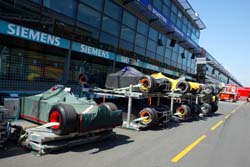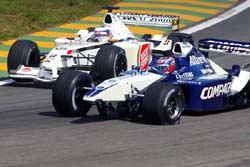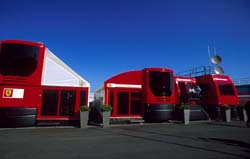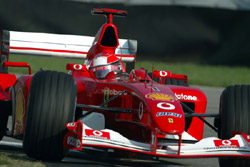
Grand Prix teams on the other hand will have spent at the very least the last five days preparing for this moment. Incredibly, even if it is their home race, just half an hour's drive from the factory, they will have a team of staff working all day from the Tuesday before the event setting up shop. And if it is on the other side of the world, such as the season opener in Australia, they will have spent even more time - it takes 16 days to prepare for the race in Melbourne.
Gone are the days when the truck rolled up to the garage, two cars and box of spanners were wheeled off, and away they went. These days transporters operating only for testing and the European races rack up around 40,000 kilometres each criss-crossing the continent. Usually there are three from the team and, for teams like BAR, a fourth will be sent from the engine supplier, in this case Honda.
Each team obviously has its own transport crew who are part of the operation of taking equipment to a race. Regardless of their job, albeit driver or assistant, once they get to the race they are part of the team over the race weekend.
While a race mechanic will have a four-day round trip (Thursday-Sunday) a 'truckie', as they are known, has to drive out and return with his transporter, so he will spend between eight and ten days going to a race and coming back.
With all the travelling it would not make sense to have to have small petrol tanks, so the refuelling bill is rather high. A tank takes 600 litres and costs £450, but at least it can travel from the factory to Europe without a break.
The home race is, of course, the easiest but ironically all the teams, including Jordan which is based literally 800 yards across the road from the circuit (a a 10 minute journey), have to go through the same complex packing procedure for their home race at the British Grand Prix as they have for races in the further flung reaches of Europe like Hungary, Spain and Italy.
Then there are other complications the fans never see; each truck has to have carnets for every single item in the 20 tonnes on board - that is basically a detailed manifesto of the contents. The trucks themselves have to be a work of art, quite literally. They may require tobacco signage on the side for the race weekend, but because it is banned as they drive through France or Germany it has to be removed and replaced along the length of a 50 foot pantechnican.
To abide with the working regulations (and general safety) each transporter has two drivers so one can sleep while the other navigates his way across Europe. That's just for the eleven races in Europe.
Then there are the "flyaways", as the Formula One™ racing fraternity calls them (Australia, Malaysia, Brazil, Canada, USA and Japan). A front line team will typically use around 22,000kg of freight - that is 59 packing cases or seven aircraft pallets packed sky high.
The bill for transporting that around the world will run to millions of pounds for each team. For those at the head of the field, much of that is covered by the freight benefits for finishing in the top ten in the FIA Formula One World Championship™. But to get their equipment moved takes FIVE specially adapted 747s run by Formula One Management.
The flight is hardly as simple as flying from A to B. Hundreds of tonnes of freight has to be loaded and unloaded. Everything has to have customs clearance and then it has to be transported from the airport to the paddock. The operation is understandably complex when you consider that every car is made up with more than 3,000 parts.
There was the case of one team who packed everything, but the specially
moulded drivers seat went astray and nearly didn't make it to the track in time.
That example shows how one missing piece can jeopardise a multi-million pound
operation. Every single part has not only to be there but to work perfectly,
too, if a car is to get through two days of practice and qualifying and then the
race on Sunday where the points are earned.

For that reason there has to be more than one spare for every single part. Allowance has to be made, too, for the fact that every driver, even Michael Schumacher, could have an 'off' and damage the bodywork.
More spares are carried for difficult tracks like Monaco and Hungary where the crash barriers are so close they are just asking to be whacked. So spare front and rear wings are among the freight along with undertrays, nose cones and repair kits.
Mechanics standing in line at the airport to check in sometimes carry things that looks suspiciously like a heavily wrapped wing end plate, or nose cone section that was not finished in time to go with the regular freight. McLaren even have a man on standby to fly parts, finished at the last minute, to race abroad.
The tide of parts is so vast that teams will design literally hundreds of wing sections in a season, and all have to be accounted for. To make sure they are not too old and close to failure they also have to be 'lifed'. So someone knows exactly how old every single part is, down to the smallest nut and bolt.
Then the freight has to include tools, generators, compressors, oxygen bottles, voltage regulators, miles of cabling, marketing equipment, dozens of computers all packed in specially made, foam-cushioned boxes, the public relations materials, press releases, promotional books, team clothing and so on.
And don't forget the hospitality area at the team motor home: they transport food, cutlery, dishes, even fridges and ovens. The leading teams even have a special refrigerated truck that sits outside the paddock and is, basically, a travelling supermarket, packed with every conceivable type of food.
Just the anatomy of the trucks alone shows how the sport has changed. In the 1950s Ferrari used one of the biggest, weighing 2.5 tonnes. Twenty years later McLaren were using a six-tonner. In 1993 Williams' transporter weighed in at a mighty 25 tonnes. Today the size of the trucks has been determined by the roads. Instead of getting bigger they just have more of them. Top teams like Ferrari, Williams and McLaren have three pantechnicans and then several support trucks as well.
In days-gone-by equipment would be packed into a truck until it was full and then the next rolled up to the door. For the last 20 years transporters have become tailor-made affairs, designed down to the last inch to take the cars (packed in double-decker style one above the other), with the surfaces where they rest also used as worktops. Above on each side are cabinets packed with tools. Such is the need for space that the trucks have special "belly lockers" between the wheels.
Packing has become a science for a very good reason. If a special part is needed in the middle of qualifying it is no good someone having to root around in a trailer for an hour. Every part has to be within easy reach in case the worst happens, and teams have one person, the logistics manager, whose sole job is to make sure it is not only there but someone knows where.
The amount of preparation that goes into a season of travelling is staggering. The BAR race team amounts to 52 people (including a 10-man catering team) and at least a dozen more from Honda. McLaren and Ferrari take more: maybe 70 people, all clocking up around 180,000 kilometres every year - equivalent to nearly five times around the planet. And the race team, made up of in excess of 60 people spend an average of 200 hours flying. That is in excess of an entire week staring at the seat in front of them at 30,000 feet.
But the operation of packing and travelling is only the beginning. Once the giant transporters arrive they have to slot into specially designated places according to where they finished in the world championship the previous year. While the unloading operation begins another man heads straight for the garage with a tin of paint.
In a habit that was started by McLaren several years ago, teams have become
increasingly zealous of their image, so the garages, which will be the central
focus of their racing efforts the next week, have to look their best. Even the
floor gets a lick of paint. Then the walls are treated, before the latest
fashion, banners and panels are unfolded and slotted into place to create false
walls (already adorned with the names of the sponsors) and a private area in the
depths of the garage.

This is divided into several smaller rooms, some for the awe-inspiring banks of telemetry screens and computer equipment, others for storage space, perhaps for catering or a meeting room or two. When the mechanics arrive on Wednesday and Thursday the garage has been transformed into a spick and span working space that looks more like an operating theatre than a garage.
The attention to detail is incredible: teams have done away with miles of cable snaking across the floor. These days the reconstruction of the garage includes the installation of an overhead gantry system to take pneumatic hoses and electric cabling. In some pits the television timing screen the driver watches in the cockpit slides overhead and out of view when he is ready to roar into action.
So vital is it for engineers to see the timing screens and on-track pictures that each team has around 50 monitors (not including computers) dotted around the pitwall, garage, meeting rooms, motorhome and hospitality area. Each one has to be wired up and checked - hence the vast array of aerials that spring from the roof of the transporter in the preparation days.
Much work is done, too, to get the vital radio communications systems working. Each line has to have a licence from the local government so it does not interfere with local police or emergency services lines.
Beyond the pits, the slick operation of setting up the digital television city works like clockwork. All the silver trucks (fifteen or so of them) are lined up in the car park in exact symmetry. The television cameras do not go there, the fans probably will never see them, and yet the transporters are always lined up in ascending order of the registration plates.
Ex-racer Jackie Stewart used to insist his team's transporters were jacked off the ground and the wheels with the names of their tyre suppliers were all in exactly the same place around the top of the rim.
But if the preparations have started on Tuesday in the garage, there are
scores of people who arrive even earlier - the catering teams. In fact if they
have been at a test nearby (and the country next door is usually regarded as
nearby!) it is a waste of time to go home for a day, so they go straight to the
track and can get there the Sunday before the race - even for a European race.

In the last three years giant multi-storey motorhomes have become all the rage. BAR started the trend with a giant two-storey edifice (and it can be called that) that blossomed from a single pantechnican into a two-storey headquarters-cum-restaurant with balcony that dated everything else in the paddock overnight. At the time it was state of the art.
Now Renault has its own version, but the place at the top of the pile has unquestionably been taken by McLaren. They are cagey about the cost but team boss Ron Dennis admitted it amounts to roughly as much as replacing the three motorhomes they were using last year.
It is a matt silver masterpiece of engineering. Transported on at least three trucks, it has laser levelling and takes something like fifteen hours over two days to construct. As well as a central entertaining area and several upstairs private offices, it has two side dining rooms, several meeting areas, a collection of well stocked kitchens and wall-to-wall flat-screen TV. There are even two outdoor balcony areas. With good reason they call it a 'communications centre' rather than just a motorhome.
When you consider that sponsors who invest millions of pounds could be wined and dined in this building, while in another part David Coulthard may be in a technical meeting, team boss Ron Dennis could on the phone in his first floor office and below someone could be preparing breakfast, lunch or dinner, it is easy to justify the expense in such a global sport.
So, when you flick on the television for the next Grand Prix, spare a thought for the hundreds of hours that have gone into making Formula One what it is.